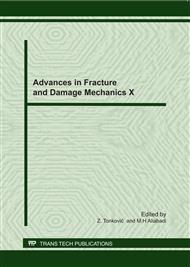p.258
p.262
p.266
p.270
p.274
p.278
p.282
p.286
p.290
Influence of the Type of Silica Fume on the Rheological and Mechanical Properties of Ultra-High Performance Concrete
Abstract:
Ultra-high performance concrete (UHPC) is a new generation of concrete developed through microstructure enhancement techniques for cementitious materials. UHPC exhibits extremely high compressive and flexural strengths exceeding 180 and 30 MPa, respectively, and remarkable durability compared to normal concretes. The fabrication of UHPC requires very low W/B ratio reaching merely 0.2, the use of large quantities of fine binder and superplasticizer without coarse aggregates, and the incorporation of steel micro-fibers. This study investigates the effect of the type of silica fume on the rheological and mechanical properties of UHPC. The adopted silica fume presents various contents of SiO2 and surface areas. From the experimental results, UHPC using silica fume with 94% of SiO2 3% of ZrO2, and surface area of 80,000 g/cm3 shows better flowability than UHPC using silica fume with 98% of SiO2 and surface area of 200,000 g/cm3 by lowering the viscosity of the cementitious composites without decreasing the compressive strength. Therefore, the fabrication cost of UHPC can be reduced by smaller dosage of superplasticizer when using silica fume with Zr content .
Info:
Periodical:
Pages:
274-277
Citation:
Online since:
September 2011
Authors:
Keywords:
Price:
Сopyright:
© 2012 Trans Tech Publications Ltd. All Rights Reserved
Share:
Citation:


